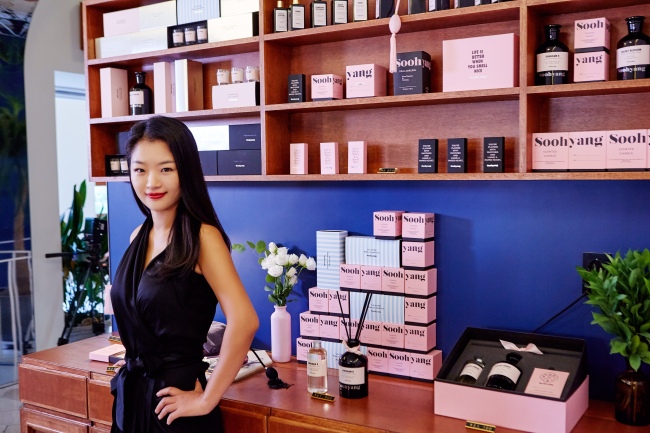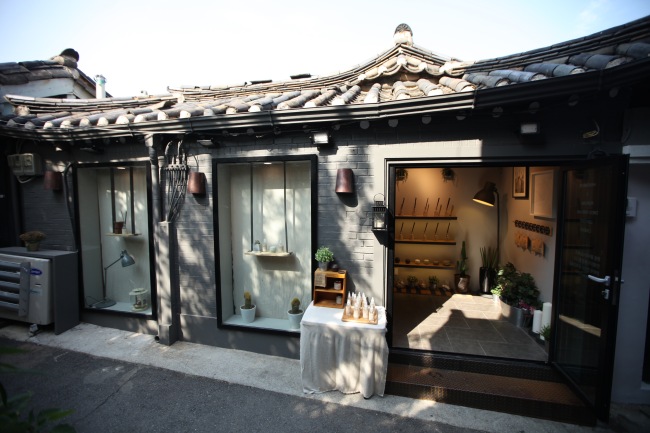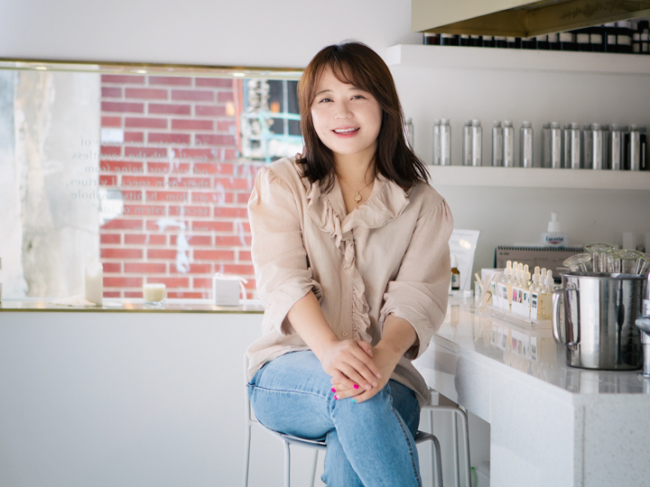If someone asked you what Seoul’s Gangnam area smelled like, how would you answer?
“Very woody and very glamorous,” said Kim Su-hyang, creative director of her eponymous perfume brand Soohyang.
A burst of citrus for the 24/7 shopping crowds of Dongdaemun. Sharp notes of patriotic red pine for Namdaemun, South Korea’s first designated National Treasure. Florals to evoke the lilac trees that bloom every April in chic Hannam-dong.
 |
Kim Su-hyang at the flagship Soohyang store in Gangnam (Soohyang) |
Soohyang is part of a new breed of Korean fragrance brands that aim to capture their country’s culture in olfactory form. They often incorporate traditional elements, or create scents inspired by locations in Korea.
In doing so, they want to carve a niche in a market traditionally dominated by European heavyweights like Diptyque and Jo Malone.
Formerly a music promoter for eight years before starting Soohyang in 2013, Su-hyang’s change of career is more logical than one would initially think.
“Music is like fragrance. It shows who you are: your tastes, your feelings and your emotions,” she said.
With Itaewon 565, the brand’s signature scent, Su-hyang also wants her location-inspired products to offer visitors a recollection of their time in Seoul.
“(Travelers) have very different thoughts about this city. Every space provides different impressions for different people,” she said.
 |
Granhand perfumer Jung Nana helps customers find their ideal fragrance (Granhand) |
Similarly, some brands seek to make their mark, but in a more traditional fashion. Wandering through the Bukchon village area, it is difficult not to notice the popularity of fragrance boutiques and workshops.
One of these is Granhand, whose more traditional aesthetics have caught not only the eye of curious tourists, but also the likes of Chanel -- Granhand candles were given to guests at the 2015 Cruise Collection in Seoul.
Located in a hanok, or traditional Korean house, the setting of the Granhand shop reflects its philosophy of a slower approach to the production process.
 |
Granhand’s Bukchon store located in a traditional Korean house (Granhand) |
“The building process of a hanok building is complicated, but there is still value in it. Similarly, it takes time to make each product in a slow process, but we believe those efforts will please the customers,” said Kim Min-su, manager of the Bukchon store.
Granhand also sells a selection of soy wax candles contained in ceramic hangari vessels. Traditionally used to ferment food such as makgeolli and kimchi, Granhand wants to showcase a more classic side of Korea that seems at odds with modern Seoul.
“Since Bukchon is a famous place for foreign people, we thought combining our candles and hangari might be a good way to express the traditional image of Korea,” said Kim.
Tucked away in another hanok area, this time in Jongno-gu’s Ikseon-dong, lies another boutique dedicated to linking fragrance to experiences.
Founded in 2015 by Han Yu-mi, Proust wants to unlock individuals’ unconscious memories of Korea through scent, like its namesake author’s madeleine in the novel “In Search of Lost Time.”
“Unlike other senses, I believe that smell is a very straightforward sensation. When we smell a strong scent, we instantly contort our facial expression. Our sense of smell is closely related to the parts of the brain that govern memory and emotion,” Han said.
Proust creates fragrances based on places that Han and her perfumers grew up in.
For example, there is an ambergris-inspired scent named “Ulsan.” A highly sought after perfuming ingredient that can only be produced by a sperm whale, the fragrance is a link to prehistoric whale carvings found in the area’s Bangudae cliffs.
 |
Proust founder Han Yu-mi (Proust) |
There are also two Seoul-inspired fragrances, Midnight in Seoul and End of the Night. Reminiscent of the passion of night, and the early dawn of a new day, Han says the fragrances should evoke the “two faces” of Seoul.
“Anyone can unravel sudden, unintended, ‘unconscious’ memory through scent. It really feels as if you have gone back to (a) moment in time and it’s very precise,” she said.
The rising trend of Korean fragrance, and the inspiration that their makers draw from their country and culture, capture only a cross-section of what Korea means to certain individuals. Not only does every place have its own color, but its own scent and memories, too. And as Soohyang’s brand motto says, life is better when you smell nice.
By Chantelle Yeung / Intern reporter (
cyeu7774@heraldcorp.com)











